Analysis of Government Intervention in Markets: ECON 1101 Week 7
VerifiedAdded on 2021/07/28
|11
|978
|122
Homework Assignment
AI Summary
This assignment analyzes the impact of government intervention on market forces, focusing on price ceilings, price floors, taxation, and subsidies. The analysis explores how these interventions affect market equilibrium, consumer and producer surplus, and the overall economic surplus. The document explains the concepts of deadweight loss, which arises when markets are prevented from reaching equilibrium due to interventions. Furthermore, it discusses the effects of taxes and subsidies on supply and demand, emphasizing the importance of elasticity in determining the magnitude of these effects. The assignment concludes by highlighting that while perfectly competitive markets often maximize total surplus, government interventions, such as those mentioned, can sometimes lead to inefficiencies and deadweight loss, although in certain cases, such as for public goods, intervention may be necessary. The assignment provides a comprehensive overview of how government policies can impact market outcomes.
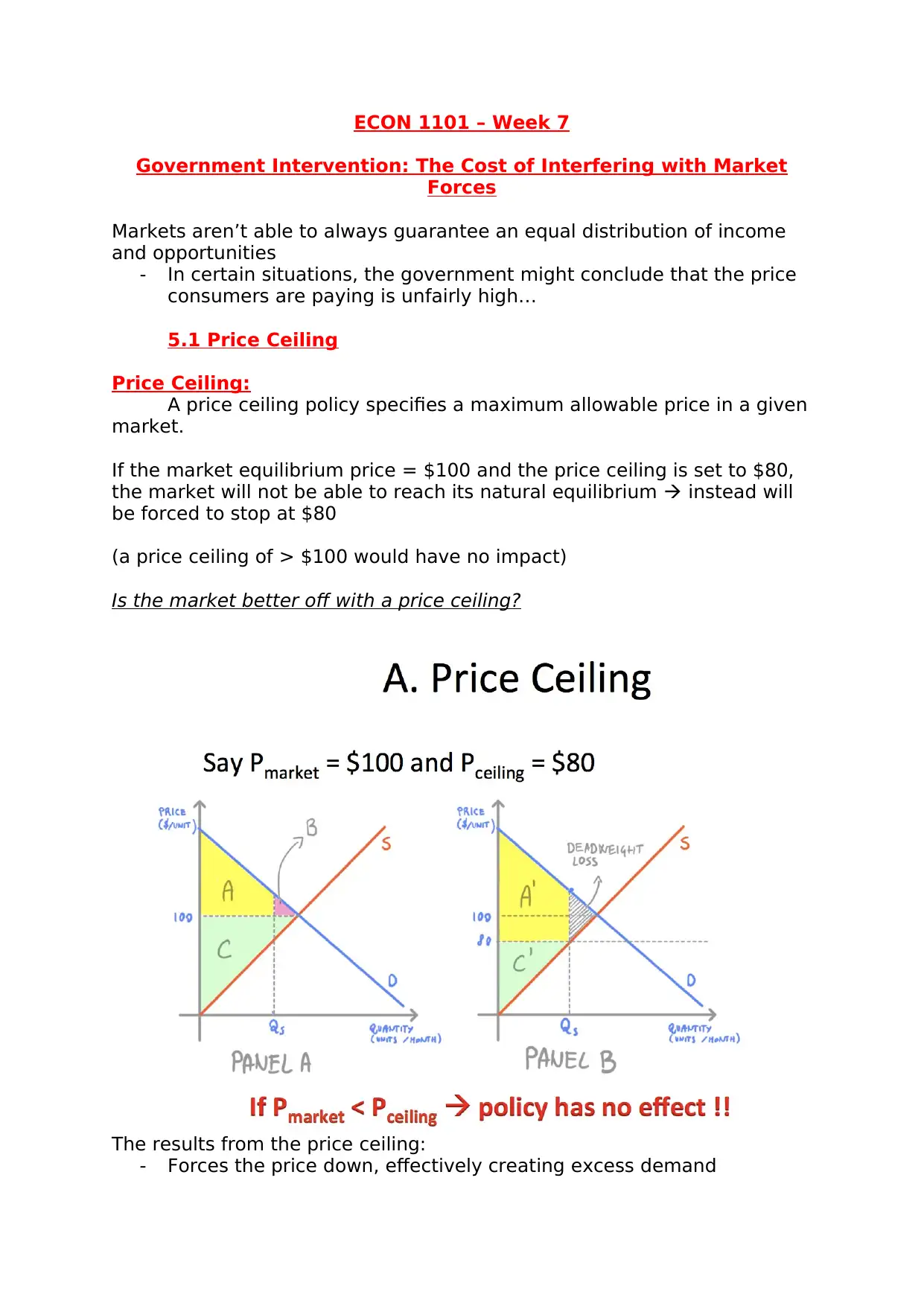
ECON 1101 – Week 7
Government Intervention: The Cost of Interfering with Market
Forces
Markets aren’t able to always guarantee an equal distribution of income
and opportunities
- In certain situations, the government might conclude that the price
consumers are paying is unfairly high…
5.1 Price Ceiling
Price Ceiling:
A price ceiling policy specifies a maximum allowable price in a given
market.
If the market equilibrium price = $100 and the price ceiling is set to $80,
the market will not be able to reach its natural equilibrium instead will
be forced to stop at $80
(a price ceiling of > $100 would have no impact)
Is the market better off with a price ceiling?
The results from the price ceiling:
- Forces the price down, effectively creating excess demand
Government Intervention: The Cost of Interfering with Market
Forces
Markets aren’t able to always guarantee an equal distribution of income
and opportunities
- In certain situations, the government might conclude that the price
consumers are paying is unfairly high…
5.1 Price Ceiling
Price Ceiling:
A price ceiling policy specifies a maximum allowable price in a given
market.
If the market equilibrium price = $100 and the price ceiling is set to $80,
the market will not be able to reach its natural equilibrium instead will
be forced to stop at $80
(a price ceiling of > $100 would have no impact)
Is the market better off with a price ceiling?
The results from the price ceiling:
- Forces the price down, effectively creating excess demand
Paraphrase This Document
Need a fresh take? Get an instant paraphrase of this document with our AI Paraphraser
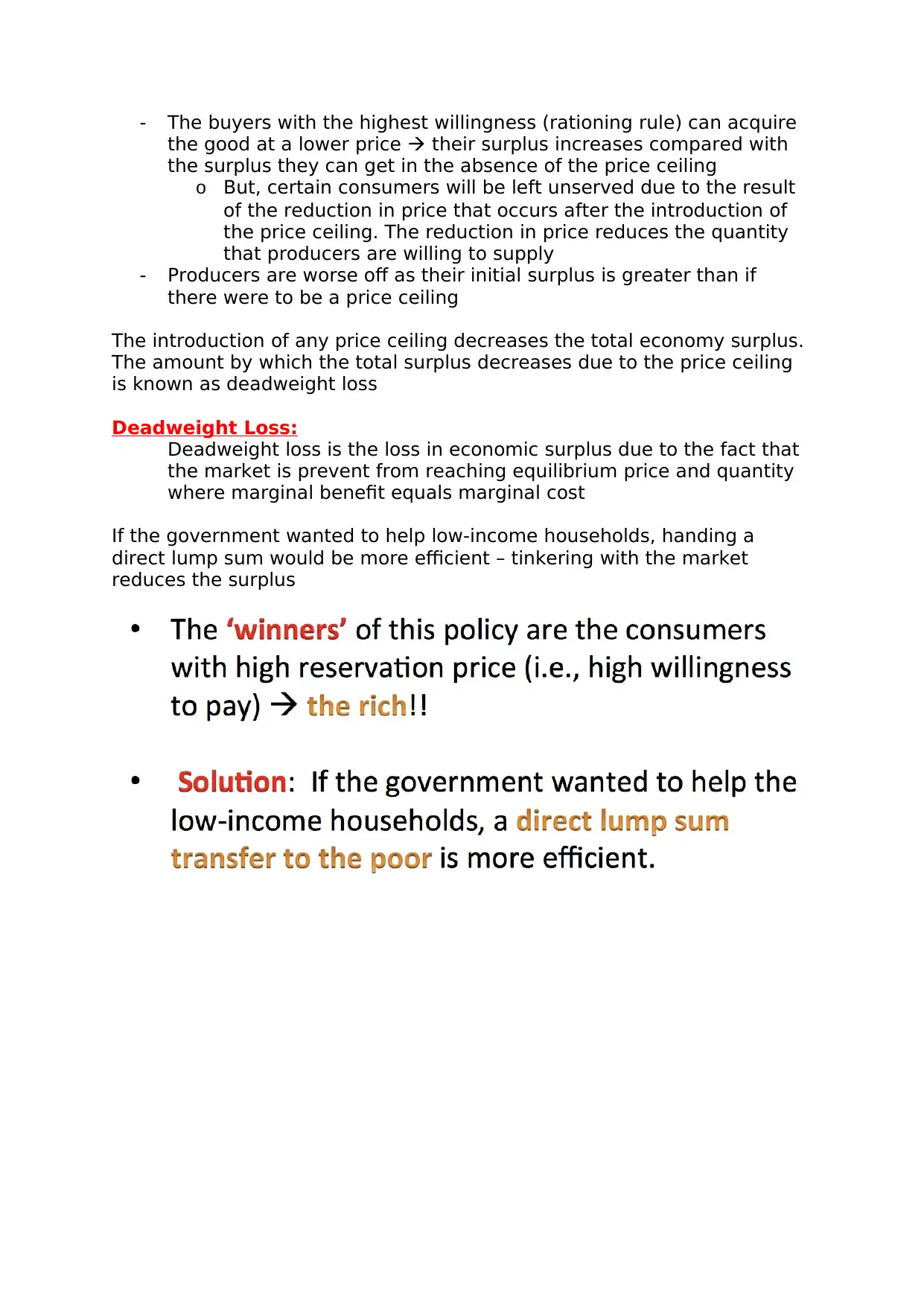
- The buyers with the highest willingness (rationing rule) can acquire
the good at a lower price their surplus increases compared with
the surplus they can get in the absence of the price ceiling
o But, certain consumers will be left unserved due to the result
of the reduction in price that occurs after the introduction of
the price ceiling. The reduction in price reduces the quantity
that producers are willing to supply
- Producers are worse off as their initial surplus is greater than if
there were to be a price ceiling
The introduction of any price ceiling decreases the total economy surplus.
The amount by which the total surplus decreases due to the price ceiling
is known as deadweight loss
Deadweight Loss:
Deadweight loss is the loss in economic surplus due to the fact that
the market is prevent from reaching equilibrium price and quantity
where marginal benefit equals marginal cost
If the government wanted to help low-income households, handing a
direct lump sum would be more efficient – tinkering with the market
reduces the surplus
the good at a lower price their surplus increases compared with
the surplus they can get in the absence of the price ceiling
o But, certain consumers will be left unserved due to the result
of the reduction in price that occurs after the introduction of
the price ceiling. The reduction in price reduces the quantity
that producers are willing to supply
- Producers are worse off as their initial surplus is greater than if
there were to be a price ceiling
The introduction of any price ceiling decreases the total economy surplus.
The amount by which the total surplus decreases due to the price ceiling
is known as deadweight loss
Deadweight Loss:
Deadweight loss is the loss in economic surplus due to the fact that
the market is prevent from reaching equilibrium price and quantity
where marginal benefit equals marginal cost
If the government wanted to help low-income households, handing a
direct lump sum would be more efficient – tinkering with the market
reduces the surplus
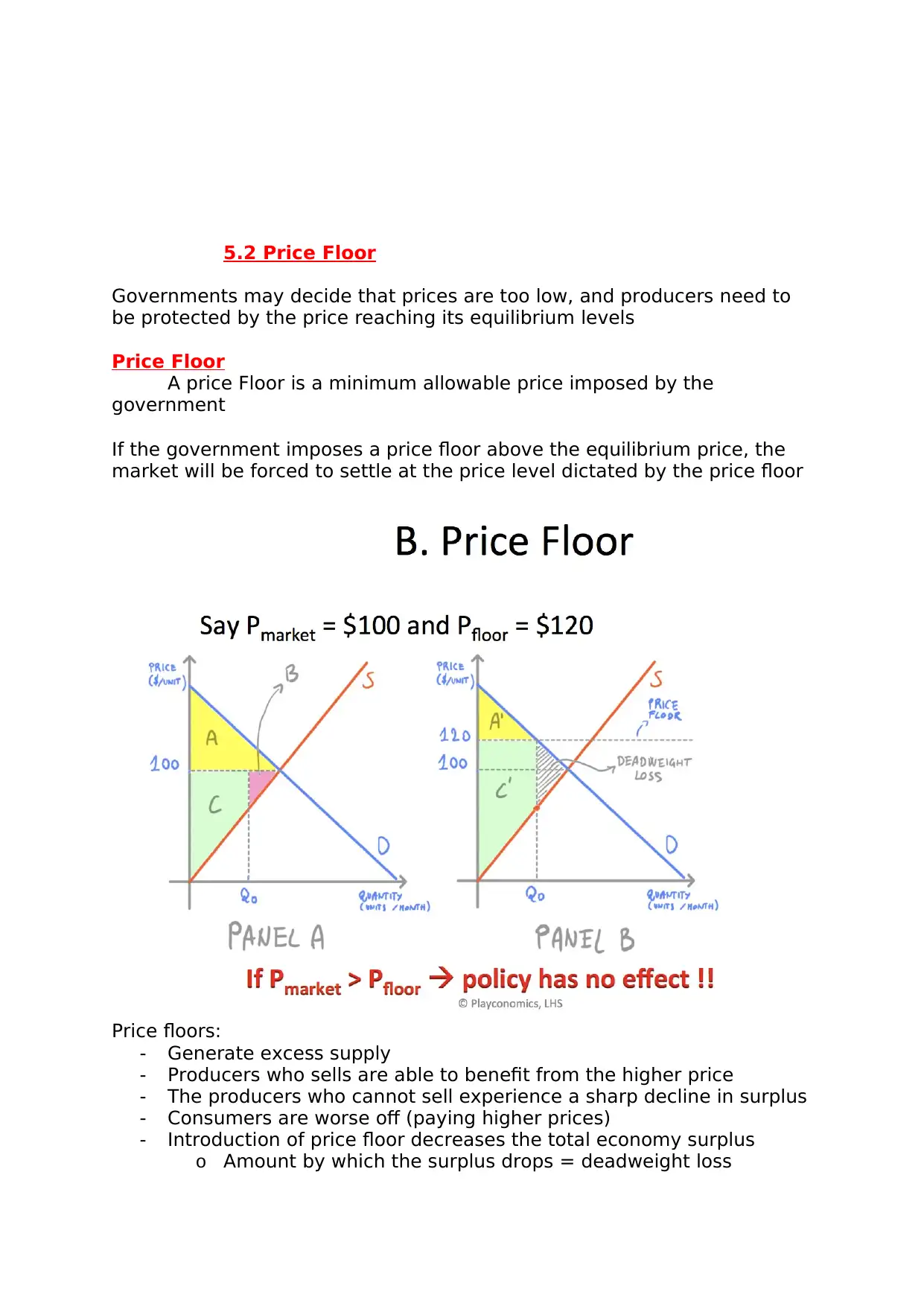
5.2 Price Floor
Governments may decide that prices are too low, and producers need to
be protected by the price reaching its equilibrium levels
Price Floor
A price Floor is a minimum allowable price imposed by the
government
If the government imposes a price floor above the equilibrium price, the
market will be forced to settle at the price level dictated by the price floor
Price floors:
- Generate excess supply
- Producers who sells are able to benefit from the higher price
- The producers who cannot sell experience a sharp decline in surplus
- Consumers are worse off (paying higher prices)
- Introduction of price floor decreases the total economy surplus
o Amount by which the surplus drops = deadweight loss
Governments may decide that prices are too low, and producers need to
be protected by the price reaching its equilibrium levels
Price Floor
A price Floor is a minimum allowable price imposed by the
government
If the government imposes a price floor above the equilibrium price, the
market will be forced to settle at the price level dictated by the price floor
Price floors:
- Generate excess supply
- Producers who sells are able to benefit from the higher price
- The producers who cannot sell experience a sharp decline in surplus
- Consumers are worse off (paying higher prices)
- Introduction of price floor decreases the total economy surplus
o Amount by which the surplus drops = deadweight loss
⊘ This is a preview!⊘
Do you want full access?
Subscribe today to unlock all pages.

Trusted by 1+ million students worldwide
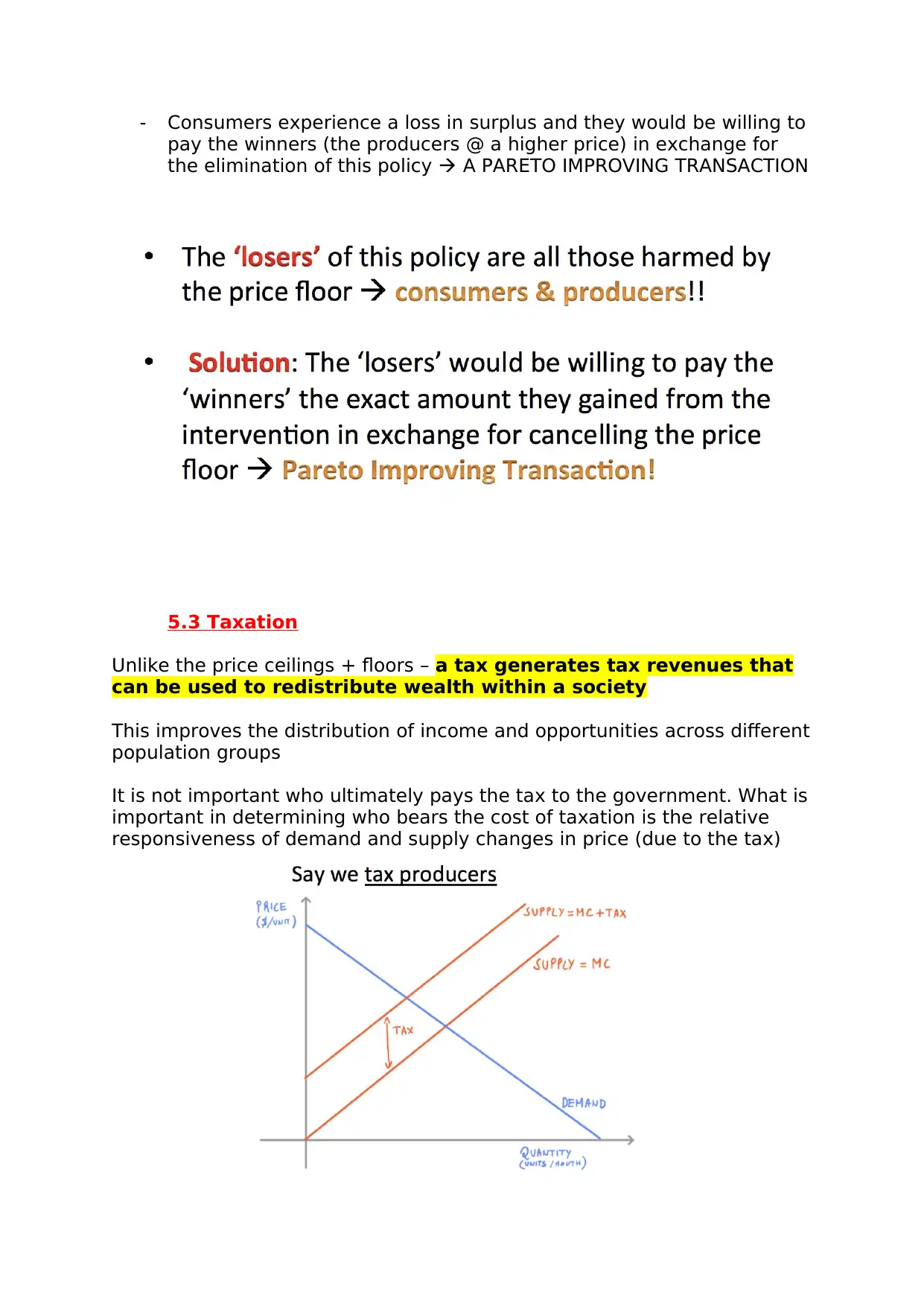
- Consumers experience a loss in surplus and they would be willing to
pay the winners (the producers @ a higher price) in exchange for
the elimination of this policy A PARETO IMPROVING TRANSACTION
5.3 Taxation
Unlike the price ceilings + floors – a tax generates tax revenues that
can be used to redistribute wealth within a society
This improves the distribution of income and opportunities across different
population groups
It is not important who ultimately pays the tax to the government. What is
important in determining who bears the cost of taxation is the relative
responsiveness of demand and supply changes in price (due to the tax)
pay the winners (the producers @ a higher price) in exchange for
the elimination of this policy A PARETO IMPROVING TRANSACTION
5.3 Taxation
Unlike the price ceilings + floors – a tax generates tax revenues that
can be used to redistribute wealth within a society
This improves the distribution of income and opportunities across different
population groups
It is not important who ultimately pays the tax to the government. What is
important in determining who bears the cost of taxation is the relative
responsiveness of demand and supply changes in price (due to the tax)
Paraphrase This Document
Need a fresh take? Get an instant paraphrase of this document with our AI Paraphraser
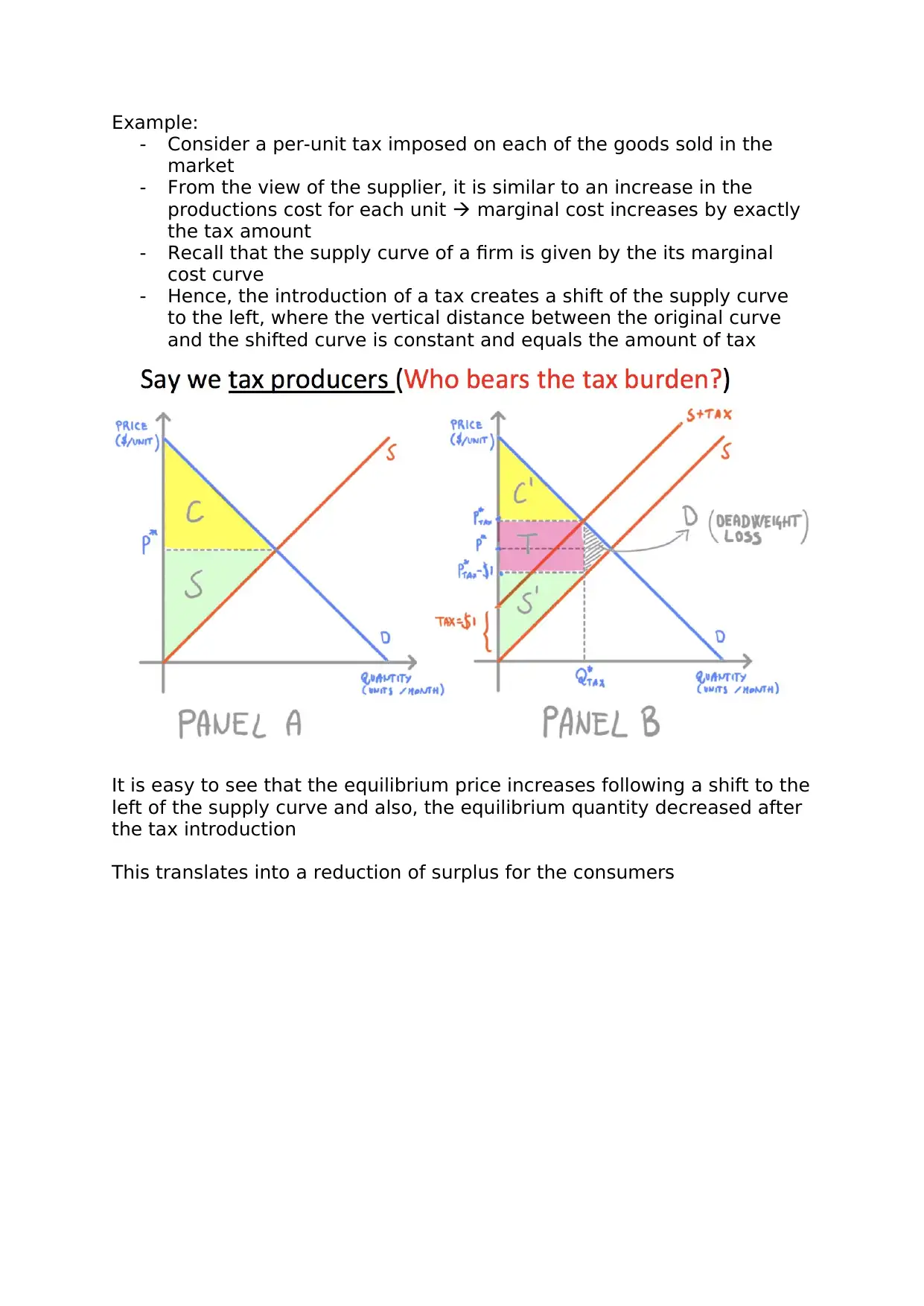
Example:
- Consider a per-unit tax imposed on each of the goods sold in the
market
- From the view of the supplier, it is similar to an increase in the
productions cost for each unit marginal cost increases by exactly
the tax amount
- Recall that the supply curve of a firm is given by the its marginal
cost curve
- Hence, the introduction of a tax creates a shift of the supply curve
to the left, where the vertical distance between the original curve
and the shifted curve is constant and equals the amount of tax
It is easy to see that the equilibrium price increases following a shift to the
left of the supply curve and also, the equilibrium quantity decreased after
the tax introduction
This translates into a reduction of surplus for the consumers
- Consider a per-unit tax imposed on each of the goods sold in the
market
- From the view of the supplier, it is similar to an increase in the
productions cost for each unit marginal cost increases by exactly
the tax amount
- Recall that the supply curve of a firm is given by the its marginal
cost curve
- Hence, the introduction of a tax creates a shift of the supply curve
to the left, where the vertical distance between the original curve
and the shifted curve is constant and equals the amount of tax
It is easy to see that the equilibrium price increases following a shift to the
left of the supply curve and also, the equilibrium quantity decreased after
the tax introduction
This translates into a reduction of surplus for the consumers
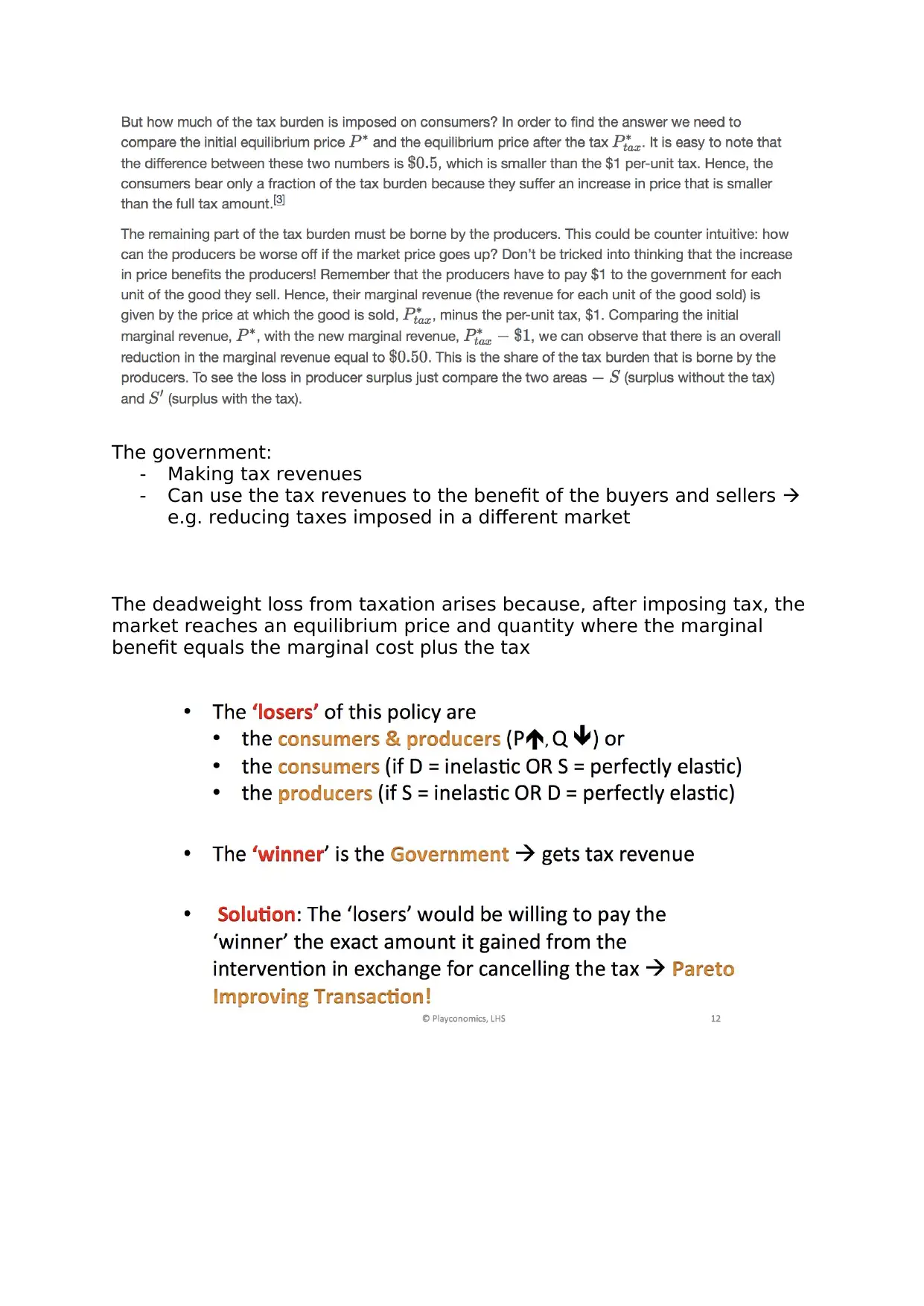
The government:
- Making tax revenues
- Can use the tax revenues to the benefit of the buyers and sellers
e.g. reducing taxes imposed in a different market
The deadweight loss from taxation arises because, after imposing tax, the
market reaches an equilibrium price and quantity where the marginal
benefit equals the marginal cost plus the tax
- Making tax revenues
- Can use the tax revenues to the benefit of the buyers and sellers
e.g. reducing taxes imposed in a different market
The deadweight loss from taxation arises because, after imposing tax, the
market reaches an equilibrium price and quantity where the marginal
benefit equals the marginal cost plus the tax
⊘ This is a preview!⊘
Do you want full access?
Subscribe today to unlock all pages.

Trusted by 1+ million students worldwide

If Supply and Demand are highly elastic even a small tax will cause a
large reduction in quantity demanded and supplied
- The larger the departure from the original equilibrium quantity, the
larger the deadweight loss is
- Also, the larger reduction in the quantity exchanged means a larger
reduction in tax revenues
large reduction in quantity demanded and supplied
- The larger the departure from the original equilibrium quantity, the
larger the deadweight loss is
- Also, the larger reduction in the quantity exchanged means a larger
reduction in tax revenues
Paraphrase This Document
Need a fresh take? Get an instant paraphrase of this document with our AI Paraphraser
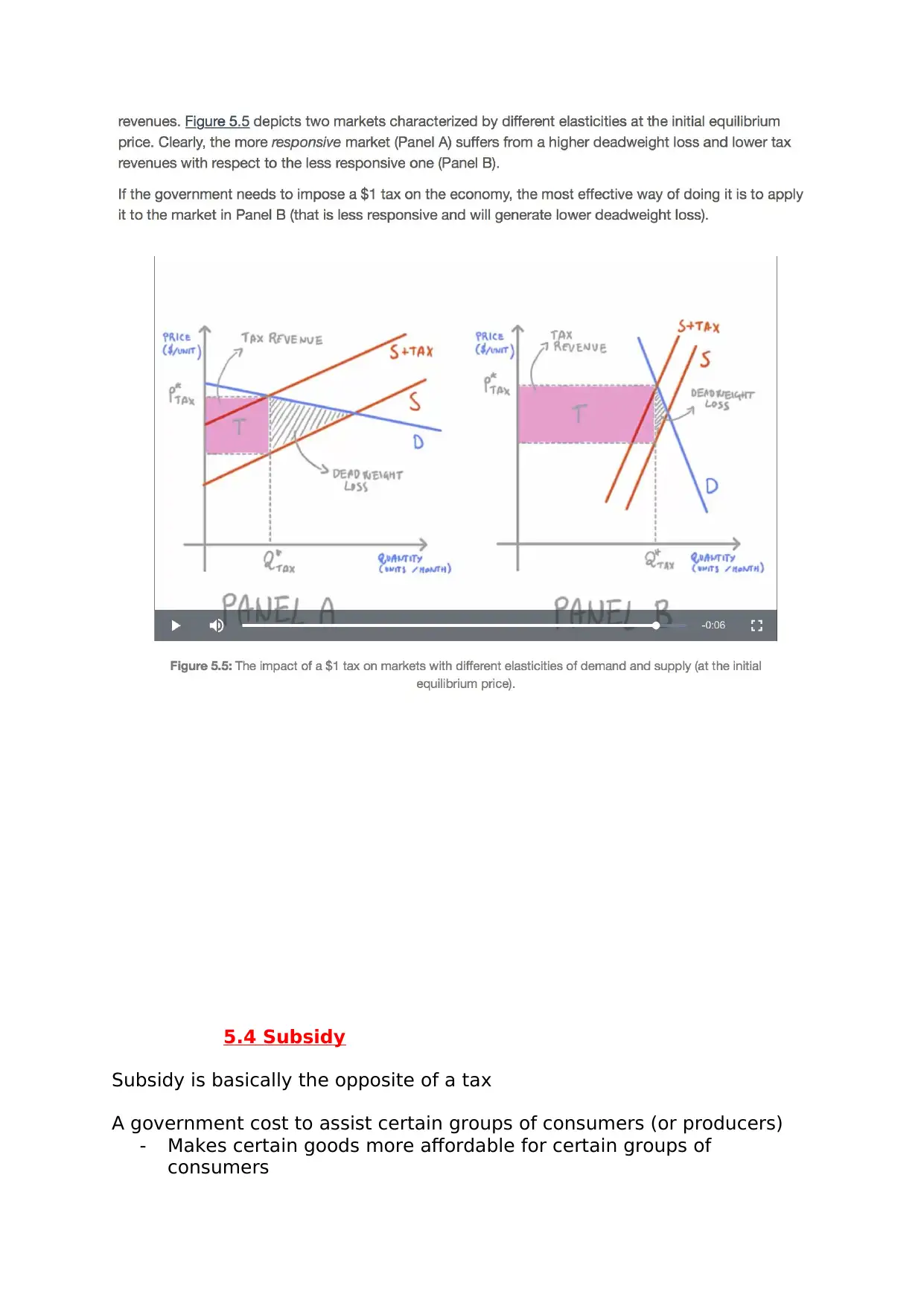
5.4 Subsidy
Subsidy is basically the opposite of a tax
A government cost to assist certain groups of consumers (or producers)
- Makes certain goods more affordable for certain groups of
consumers
Subsidy is basically the opposite of a tax
A government cost to assist certain groups of consumers (or producers)
- Makes certain goods more affordable for certain groups of
consumers
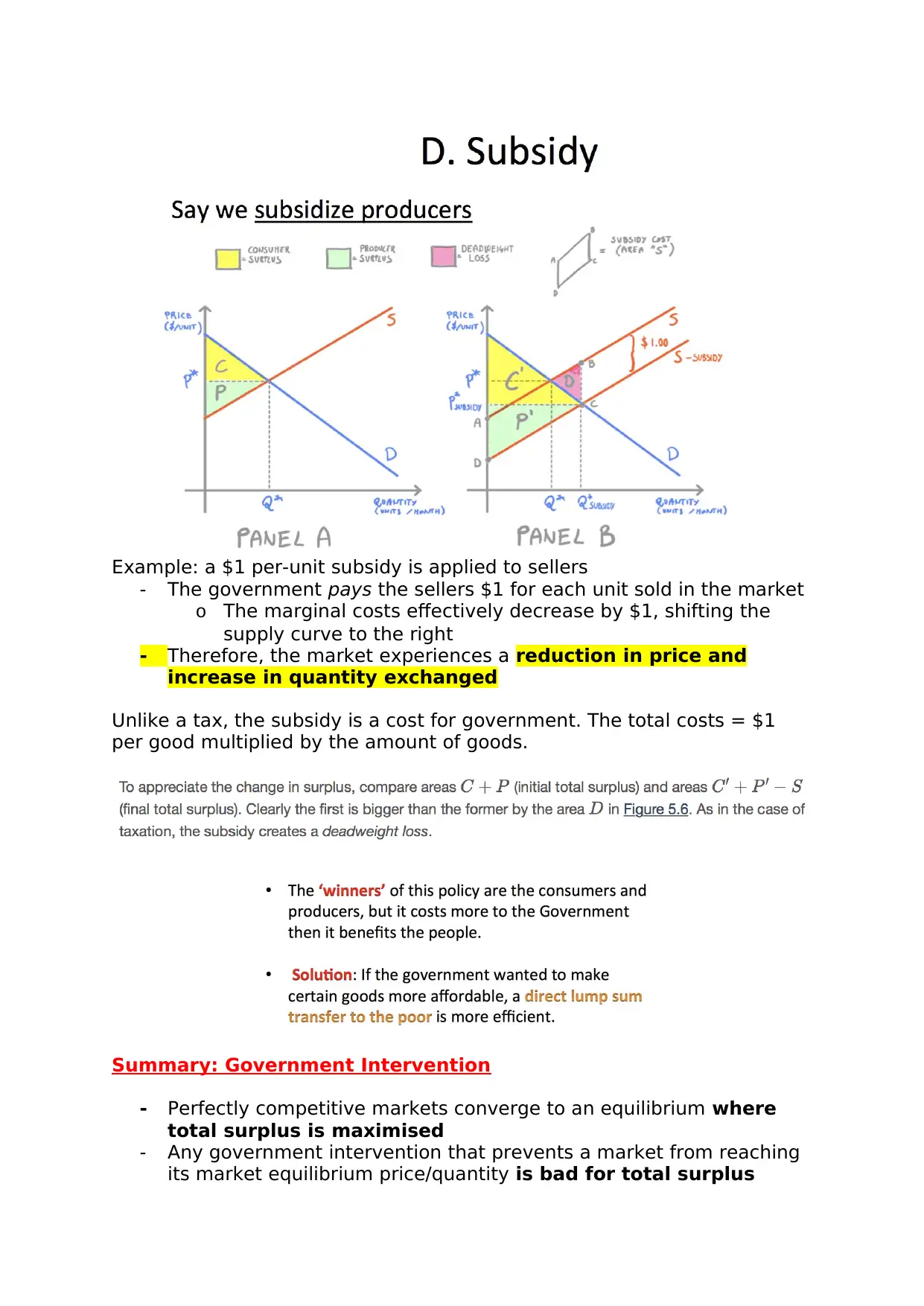
Example: a $1 per-unit subsidy is applied to sellers
- The government pays the sellers $1 for each unit sold in the market
o The marginal costs effectively decrease by $1, shifting the
supply curve to the right
- Therefore, the market experiences a reduction in price and
increase in quantity exchanged
Unlike a tax, the subsidy is a cost for government. The total costs = $1
per good multiplied by the amount of goods.
Summary: Government Intervention
- Perfectly competitive markets converge to an equilibrium where
total surplus is maximised
- Any government intervention that prevents a market from reaching
its market equilibrium price/quantity is bad for total surplus
- The government pays the sellers $1 for each unit sold in the market
o The marginal costs effectively decrease by $1, shifting the
supply curve to the right
- Therefore, the market experiences a reduction in price and
increase in quantity exchanged
Unlike a tax, the subsidy is a cost for government. The total costs = $1
per good multiplied by the amount of goods.
Summary: Government Intervention
- Perfectly competitive markets converge to an equilibrium where
total surplus is maximised
- Any government intervention that prevents a market from reaching
its market equilibrium price/quantity is bad for total surplus
⊘ This is a preview!⊘
Do you want full access?
Subscribe today to unlock all pages.

Trusted by 1+ million students worldwide
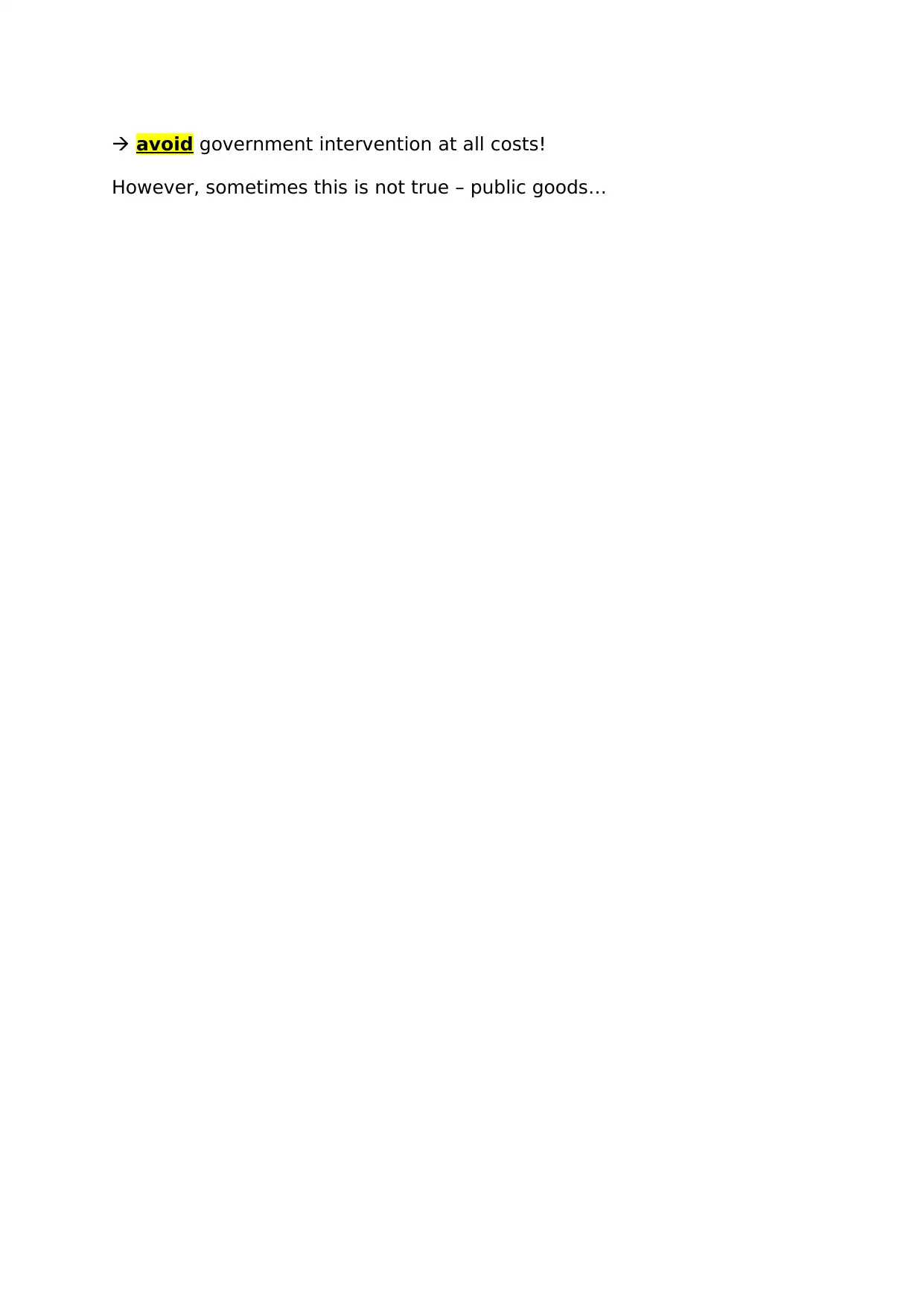
avoid government intervention at all costs!
However, sometimes this is not true – public goods…
However, sometimes this is not true – public goods…
Paraphrase This Document
Need a fresh take? Get an instant paraphrase of this document with our AI Paraphraser

1 out of 11
Related Documents
Your All-in-One AI-Powered Toolkit for Academic Success.
+13062052269
info@desklib.com
Available 24*7 on WhatsApp / Email
![[object Object]](/_next/static/media/star-bottom.7253800d.svg)
Unlock your academic potential
Copyright © 2020–2025 A2Z Services. All Rights Reserved. Developed and managed by ZUCOL.





